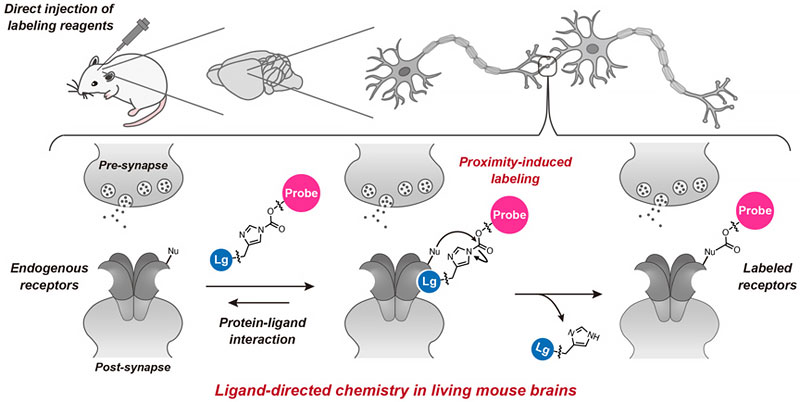Kyoto University Professor Itaru Hamachi, Associate Professor Hiroshi Nonaka, Associate Professor Kiyoshi Sakamoto, and doctoral student Kazuki Shiraiwa have developed a new method of labeling naïve neurotransmitter receptor proteins in living animal brains.
Conventionally, proteins emitting fluorescent (fluorescent protein), which can be a landmark, were expressed in a state fused to proteins produced by genetic modification and observed. However, due to concerns about (1) genetic modification being necessary, (2) functional hindrance of the fused proteins to the target protein, and (3) concerns about defects during expression, there was a demand to develop technology to mark (label) proteins in a more natural state.
For the first in the world, the research group succeeded in chemically labeling natural neurotransmitter receptors in mouse brains without genetic manipulation by using ligand-directed acylimidazole chemistry (LDAI chemistry)(1). By pulse-chase analysis(2) of AMPA-type glutamate receptors (AMPA receptors)(3) in the postnatal developmental brain utilizing this method, it was clarified that AMPA receptors that once performed a function moved to synapses that play different roles and are reused.
In principle, this technology can be applied not only to mice but also to other species. Developments can also be expected for many species, including primates such as marmosets, where labeling a target is difficult with genetic methodologies. Furthermore, it can be directly applied to model animal experimental systems (disease models, genetically modified mice, etc.) established to date by researchers around the world, and one can expect that relationships between pathology and receptor dynamics will be clarified. In addition, this technology is not only developed to analyze the fate (movement and lifespan) of proteins, but it can be useful for elucidating the function of natural proteins in individual animals by introducing various functional molecules in the future, and the research is ongoing.
This research was conducted in collaboration with Professor Shigeki Kiyonaka of Nagoya University, Professor Etsuo Susaki of Juntendo University, Professor Hiroki Ueda of the University of Tokyo, Professor Michisuke Yuzaki, Associate Professor Wataru Kakegawa, and Assistant Professor Itaru Arai of Keio University.
These results were obtained through the JST Exploratory Research for Advanced Technology (ERATO) “Hamachi Innovative Molecular Technology for Neuroscience” (JPMJER 1802). The research project aims to accurately elucidate information transmission and intercellular network formation within the nervous system and brain at the level of individual protein molecules by creating innovative “chemical biology molecular techniques.”
(1) Ligand-directed acylimidazole chemistry (LDAI chemistry)
A technique developed by the study group to chemically modify naturally occurring proteins. In "LDAI chemistry," a ligand with affinity for the target protein and a functional molecule to be introduced into the target protein are used as a protein labeling reagent (labeling agent) connected by a reaction site (dissociative electrophile: acylimidazole). Upon recognition of the ligand, the reaction site of the labeling reagent and the amino acid side chain are in close proximity, accelerating the transfer reaction, and the selective modification becomes feasible. During this reaction, the ligand is designed to dissociate without covalent attachment to the protein, thus retaining the original function of the protein.
The labeling selectivity of this method depends on the nature of the ligand (protein selectivity, hydrophilicity, hydrophobicity) and the relationship between the reaction site of the labeling agent and the reactive amino acids on the target protein. In this approach, it is difficult to target proteins that lack ligand selectivity or lack ligands. The study group attempts to optimize performance by selecting ligands that exhibit good properties and by optimizing the molecular design of the entire labeling agent such as location of reaction sites.
(2) Pulse Chase Analysis
An analysis method where labeling is performed by exposing the object to labeled compounds for a short time (pulse) in a cell or organism. The condition is then set to not labeling, and the labeled object is tracked (chased) to observe how it moves.
(3) AMPA glutamate receptor (AMPAR receptor)
A type of ion-channel glutamate receptor that is widely distributed in the central nervous system and is highly involved in memory and learning.
-

Fig.1 Chemical labeling of neurotransmitter receptors in the living mouse brain Schematic illustration of the ligand-directed chemistry in the living mouse brain.
Nu, nucleophilic amino- acid residue. Lg, selective ligand for each receptor.
© ERATO Hamachi Innovative molecular technology for neuroscience
Program Information
- JST ERATO
- “HAMACHI Innovative Molecular Technology for Neuroscience”
Journal Information
Hiroshi Nonaka, Seiji Sakamoto, Kazuki Shiraiwa, and Itaru Hamachi, “Bioorthogonal chemical labeling of endogenous neurotransmitter receptors in living mouse brains”, Proceedings of the National Academy of Sciences (PNAS). Published online January 31, 2024,
doi: doi:10.1073/pnas.2313887121
Contact
-
[About Research]
Itaru Hamachi
Professor, Graduate School of Engineering, Kyoto University
Tel:+81-75-383-2754 Fax:+81-75-383-2759
E-mail: ihamachisbchem.kyoto-u.ac.jp
-
[About Program]
Fumie Imabayashi
Department of Research Project, JST
E-mail: eratowwwjst.go.jp
